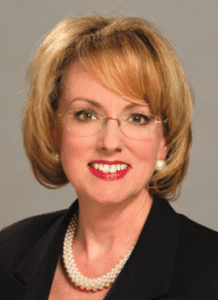Outdated jargon undermines nurse practitioner role.


Why do we use slang to describe a licensed advanced practitioner? “Mid-level” is outdated, and it misleads the public into thinking the care provided isn’t “high-level.” Imagine what “mid-level” must sound like to a patient or family member.
I did a literature search to discover the origin of the term, but I didn’t find much other than its frequent use in articles and research. However, I did learn that the U.S. government doesn’t use the term. Payers and regulators have terms known as “identifiers” for NPs and physician assistants (PAs) that are used for billing and monitoring. For example, the U.S. Department of Health and Human Services Medicare program uses “nonphysician practitioner” to describe advanced practice RNs (APRNs) and PAs.
Some physician groups criticize hiring NPs instead of medical doctors, asserting that cost is becoming a priority over patient care and safety. Suggesting that NP care is dangerous and less than the care provided by physicians is unacceptable.
All NPs have advanced clinical training and competency to provide healthcare beyond their initial RN preparation. NPs have graduate education, with master’s or doctoral degrees. The high quality of care they provide, which has been well-documented by research, should be without debate.
The American Nurses Association represents the interests of all APRNs and is a founding member of the Coalition for Patients’ Rights, which was formed to address the American Medical Association’s scope of practice campaign dedicated to limiting the scope of practice for APRNs and other licensed professionals.
What can you do? Support change with two important actions:
- Never use the term “mid-level”—spoken or in print—to describe an NP. Correct others “in the moment” by asking them to use the term nurse practitioner.
- Request that your organization stop using “mid-level” in reference to NPs.
Nothing about NPs is “mid.” Let’s educate our organizations, our patients, and our communities about that fact. Americans make more than 1.06 billion visits to NPs a year, so let’s ensure that they worry only about their illness, not the competency of those providing care.
– Lillee Gelinas, MSN, RN, CPPS, FAAN, Editor-in-Chief
References
American Association of Nurse Practitioners. Quality of nurse practitioner practice. 2015. aanp.org/advocacy/advocacy-resource/position-statements/quality-of-nurse-practitioner-practice
American Nurses Association. Advanced practice registered nurses (APRN). nursingworld.org/practice-policy/aprn/
U.S. Department of Health and Human Services: Office of Inspector General. Medicare Coverage of Non-physician Practitioner Services. June 2001. oig.hhs.gov/oei/reports/oei-02-00-00290.pdf



















3 Comments.
I wanted to thank you for your editorial on the outdated jargon of mid-level for advanced practice providers. As an adult nurse practitioner, I have used my voice and the American Association of Nurse Practitioner position statement on the use of terms such as mid-level provider and physician extender to educate others on the inappropriate use of these terms. I know that when you apply for a DEA license to prescribe controlled substances, you have to select your role and the term “mid-level” is there. Maybe this is where that term started?
Thanks again!
Beverly S. Karas-Irwin, DNP, RN, NP-C, HNB-BC, NEA-BC
Thank you Editor Gelinas and Dr. Laustsen,
I too read with interest the February Editorial Column and response. In response to both, first thank you! The terms “mid-level” and “non-physician provider” are like fingernails on a chalk board – ARGH!!!!! What’s in a name? Yes, all of this and more!
Respectfully request to please use the term APRN more globally vs NP – as the issue surrounding “what’s in a name” is relevant to all APRNs – whether one is a CNM, CNS, CRNA, or NP. Our state organization (ANA constituent!) has worked diligently to represent ALL APRNs in our state through the APRN Congress. It is a sticking point for some, although I am not aware of another nursing organization that represents all APRNs – although I certainly am a member of the national NP group (AANP) as well, their focus is as the name suggests – is on NPs.
ANA – at least to this nurse, represents all nurses. I take pride in that our APRN Congress collectively addresses all APRN issues through the state legislature and is the voice for nursing in our state. These collective efforts are much more effective as we support each other (constituent and other specialty organizations) in similar but unique professional challenges regarding SOP, access to care, pay equity, etc…
Lumping together APRNs and PAs has unfortunately become fashionable under the umbrella term “APPs” or advanced practice professionals. Frankly, I’d rather stand in the rain…
Ironically, I was just on a national call, in which some nurses were discouraging their state’s APRNs who are DNPs, from using the title “doctor” – as it upset some physicians and subsequently some legislators. PLEASE pass me some Zofran!!!!
Again, thank you both for reinforcing ANA’s role in addressing SOP issues, especially with other professions that have yet to recognize the most excellent care APRNs deliver; for addressing outdated language, and strategies to address. I believe it is through consistent professionally messaging such as this editorial and response(s) we first help ourselves to grasp the importance of “words matter”, to enable all nurses to educate the public and others about us.
Respectfully,
Sandra Cotton, DNP, APRN, ANP-BC, FNAP
Ms Lillee Gelinas, MSN, RN, CPPS, FAAN,
I read your editorial in the February 2020 edition of the American Nurse and want to thank you for calling attention to the issue of outdated jargon related to categorizing nurse practitioners. Your comments were appreciated and it is beneficial to see ANA’s journal addressing this topic.
However, I would encourage you to recognize the opportunity to further expand how you addressed this topic. In the editorial (and in many healthcare systems), the term “nonphysician practitioner” is used in reference to APRNs and PAs. I would suggest that you apply the same critique of this categorization as you did with the “mid-level” designation. Nurse practitioners are not a “non” anything but are a very positive, contributing group of healthcare professionals. Paraphrasing your words from the editorial, “Nonphysician” is outdated, and it misleads the public into thinking the care provided isn’t equivalent to physician care. Imagine what “nonphysician” must sound like to a patient or family member.
Regardless of what terminology insurers, the Federal Government, or other healthcare providers and systems use in reference to nurse practitioners, I think nurses and our professional organizations should continue to advocate for the positive role nurse practitioners provide to our patients and public health. I support your suggestions of how we can address the improper use of terms referencing nurse practitioners by:
1. Never use the term “nonphysician” to describe an NP and correct others.
2. Request organizations stop using “nonphysicians” in reference to NPs.
Nothing about NPs’ is “non”.
Thank you again for your editorial and promoting the recognition of nurse practitioners.
Please feel free to contact me if you have any questions about my comments.
Respectfully,
Gary Laustsen, PhD, APRN(FNP), RN, FAANP, FAAN